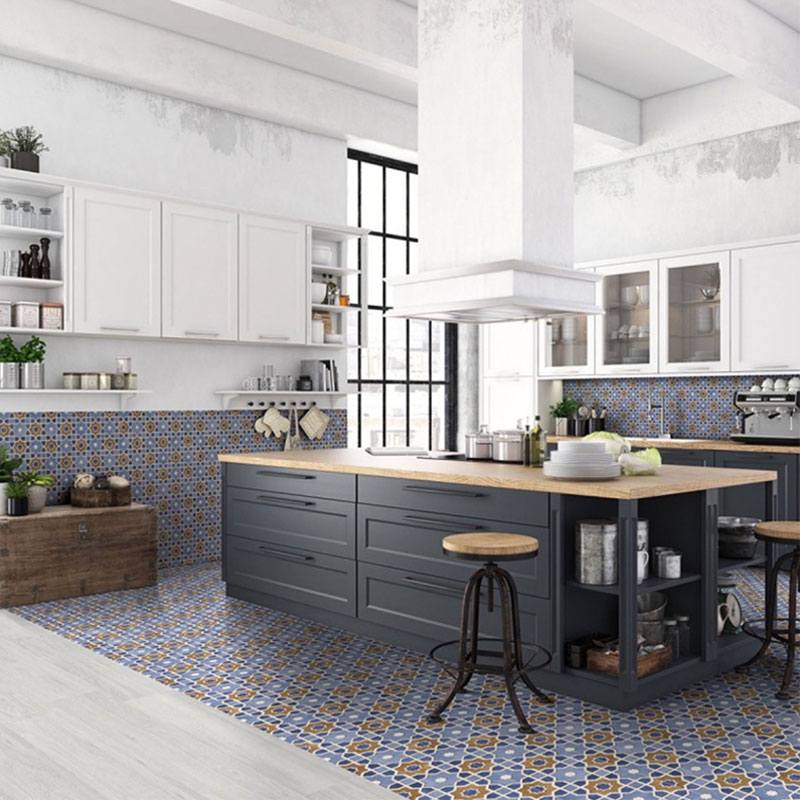Imitation hydraulic floors are suitable for renovating any room in your home. Whether in the bathroom, kitchen or living room. But what exactly are they and what advantages do they provide in terms of functionality and design? In ParaTuReforma we want to tell you everything you should know about them.
What are imitation hydraulic floors?
Hydraulic floors were a trend in the world of interior design for a long time. In fact, until the 1960s, they were the most widely installed in homes around the world. The reason? They were exceptionally hard-wearing and also boasted very elegant designs, usually in the form of mosaics.
This type of tile was invented in France in the mid-nineteenth century and was a real revolution in the world of interior decoration. We are sure that if you or a relative of yours has an old house in the countryside or in the city, this type of tile is present in some room.
Specifically, hydraulic floors were made from compacted cement. They owe their name to the use of a hydraulic press to obtain each tile. They were then subjected to an artisanal design process by which they were embellished with the mosaics that have made them so popular.
Imitation of hydraulic floors: how is it achieved and what are the advantages?
The high cost of hydraulic floors and the disadvantages of the material used meant that they gradually lost weight in homes. After all, although they were hard and provided total resistance to humidity, they chipped relatively easily. In addition, their designs lost color and luster over time.
It was precisely these designs that allowed them to stand the test of time. In fact, they managed to become icons of retro and vintage decorative styles. However, they began to be recreated using other more modern, easy to install and effective materials in the home.
Specifically, when we talk about imitation hydraulic floors, we refer to a set of porcelain stoneware tiles manufactured following the same style patterns. This material provides a number of unquestionable advantages over pressed cement:
- It is much easier to install.
- It allows the elimination of joints, which is very useful in spaces marked by humidity and condensation, such as the kitchen or bathroom.
- It requires no maintenance to preserve its aesthetic and functional qualities over time.
- It is very resistant. To the point that, in order to get it to splinter, it would have to be subjected to a very strong blow.
- It has a non-slip surface, which reduces the risk of slipping and domestic accidents.
- It reproduces the typical mosaics of the original hydraulic floors with such a degree of fidelity that it is impossible to differentiate them at a glance.
- It is much easier to clean. This is mainly because it has a non-porous surface that does not absorb dirt.
- It is compatible with the installation of underfloor heating systems.
- It has an unbeatable quality-price ratio.
Where can imitation hydraulic floors be installed?
Literally, in any area of the house. Especially, if you have decorated with rustic style pieces. Due to the qualities we have mentioned above, this type of cladding is empowered to meet all your needs both in the kitchen and in the bathroom, but also in the living room or in the bedrooms.
In addition, it is common nowadays to use them to separate different rooms in loft apartments, i.e. where there are no doors or walls. It is also common to place them as “carpets” in certain areas. For example, under the coffee table in the living room. They are even suitable for terraces, balconies and outdoor patios.
Most popular imitation hydraulic flooring designs
As we have already mentioned, when installing imitation hydraulic floors you have a wide variety of options. Therefore, we want to make a tour of the styles most demanded by our customers:
- Arabic style. It is characterized, mainly, by the use of small tiles (20 x 20 cm, approximately) marked by colorful designs and geometric elements. They give a touch of tradition and elegance to any environment. A good example is our Mudéjar De Keros collection.
- Classic or retro style. In most cases, the aesthetics of these tiles are reminiscent of the wallpaper that decorated our grandparents’ homes decades ago. Yellow, brown and pink tones are usually the protagonists, as you can see in our Nostalgy collection by Mainzu.
- Worn style. It’s funny, but these hydraulic tiles that are more than 100 years old and worn by use and the passage of time have a special charm. The creators of Harmony’s Casablanca collection know this and have given them this effect.
- Tapestry style. Faux tile flooring can also emulate the aesthetics of tapestry. Although this trend is more popular for wall coverings, it also enjoys great popularity in this area. The Paris collection by Keros demonstrates this.

To these styles we should add another innovation that the use of ceramic stoneware has made possible. We are talking, of course, about the manufacture of large formats that, in many cases, are associated with tiles up to 25 centimeters wide and 75 centimeters long. This helps to further conceal the joints between each tile and create a greater sense of continuity.
Obviously, being larger in size, the pieces are more brittle before placement. After that, they provide exactly the same performance as the undersized ones. This usually requires the intervention of an experienced professional and the purchase of a few more pieces than necessary to avoid unforeseen circumstances.
In any case, we could spend all day talking about the different styles of faux tile flooring. However, we think it is clear that, thanks to the versatility of porcelain stoneware, any design is possible. Take a look at our catalog to check it out and, if you want to know more, do not hesitate to contact us.


